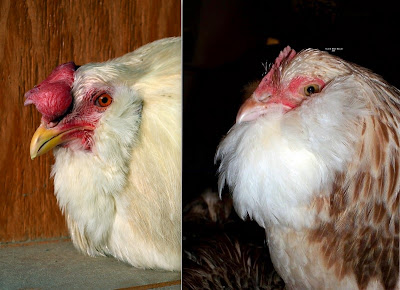Beard and muffs are inherited as one unit. It consists of a feathered throat and pointy (sometimes) tufts that are positioned just forward of the true ear on the head.
This is another of Arthur O. Schilling's illustrations. Crest and beard are inherited independently of each other.
Dr. Hutt has little to say about "Muffs and Beard". He considers it an incompletely dominant trait, Mb, because of variable expression in the heterozygote (pg. 129 Genetics of the Fowl, 1949), controlled by an autosomal gene. I say it simply depends on what kind of chicken you introduce it to. If you introduce it to a predominantly Red Jungle Fowl type of breed and you get something rather odd.
The bird on the left is my own, a cross of a White Leghorn over an Ameraucana hen. The picture on the right is a champion Salmon Faverolle pullet belonging to a friend of mine.
On an Asiatic/Oriental breed it appears much more natural.
The beard covers the throat smoothly like the feathered throat of any other bird. This may be related to a feather characteristic known as 'hard' feather as opposed to 'soft' feather. The difference between the two is in the angle at which the feathers emerge from the skin.
"Hard feathered breeds such as the Old English Game, Modern Game, Aseel, Cornish, and Malay have feathers that emerge from the skin at a low angle and thus lay tightly to the body. Feathers of this type are usually shorter and more brittle and snap like a spring when raised. Soft-feathered breeds have soft fluffy feathers that emerge from the skin at a much greater angle and thus give an appearance of openness...."
"When crosses have been made between hard and soft feathered breeds, many investigators have found that hard feathering is dominant (Jull, 1940).... The gene symbol Ha is proposed for this (single) gene."
(R. G. Somes, Jr., pg 178, Chap. 6 of Poultry Breeding and Genetics, R. D. Crawford, Editor)
So here you have two characters that mesh, two puzzle pieces as it were; feathered throat and angle of feather.
The 'muff' portion of the beard and muff appears as tufts in hard feathered birds and serves to hide the true ear (ear opening is covered by stiff auricular feathers) and ear 'lobe' or ear 'lappets' below from the front while not obstructing vision.
This raises interesting questions as to how these birds fed. Why would the bird's appearance be masked from the front and below by both crest and beard?
Reference
Jull, M.A., 1940. Poultry Breeding, 2nd ed. John Wiley and Sons, Inc., New York.




No comments:
Post a Comment